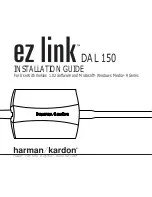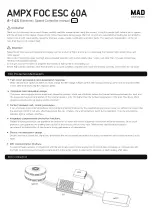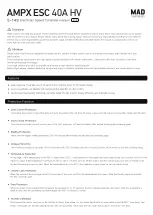
19
16
8. See further instructions for both manual and hydraulic
type front loader mounts.
3. Prepare the driving ram for attaching to the hydraulic
base mount. To do this, first lower the driving ram to its
lowest transport position. The driving ram is shipped in
the upper transport position for compactness. To lower
the ram, pull the transport lock pin, allow the ram to
lower (approximately 10 inches) and replace the
transport lock pin. This should be done with the Driver
laying on the shipping pallet. The ram is spring loaded
downward. Stand clear of the ram when the pin is
removed (see Figure D).
NOTE:
This step of
repositioning the driving ram is necessary in order to
make the mounting bolts at the correct height when
the unit is stood upright for the next step.
INSTRUCTIONS
(continued)
FIG. D
4. Attach the driving ram assembly to the hydraulic base
mount. A chain hoist or forklift can be used to stand
the driving ram assembly to its normal (vertical) work-
ing position. Take care not to damage the hydraulic
cylinder or carriage when lifting the unit. Once the ram
assembly is upright, remove the six (6) nuts and lock
washers from the mounting bolts.
Align the mounting bolts with the six (6) holes in the
mounting channel and secure with the nuts and lock
washers. The mounting channel on the hydraulic base
mount will probably have to be positioned by hand to
get the mounting channel and carriage lined up.
NOTE:
One mounting bolt goes into a blind hole and
does not get a nut and lock washer. Due to trapped air,
it may be necessary to operate the control levers on
the multi-spool valve in order to position the mounting
channel on the hydraulic base unit. Plastic plugs or
hose end caps may have to be removed to allow
trapped air in the hydraulic cylinders to escape.
DO
NOT ATTEMPT TO CONNECT THE VALVE TO THE
TRACTOR AND OPERATE IT AT THIS TIME.
When
properly mounted, the bottom of the driving ram
should be resting on the same level surface as the
mounting base. This should keep the driving ram
assembly in a vertical position.
NOTE:
The driving
ram assembly will be somewhat unstable until the
hydraulic cylinders are filled with oil once all plumbing
is completed.
FOR HYDRAULIC ADJUSTED UNITS –
(HPD-16 HFL and HPD-20 HFL)
1. Attach the forward extension frame and base mount
for hydraulically adjusted units to the main frame. It
can also be located anywhere along the main frame
but it is recommended that it be located on the left side
so the post driver will be offset.
The hydraulic extension frame and base mount is
shipped with some of the hydraulic system partially
plumbed and ready to accept the driving ram
assembly. The multi-spool valve and mounting plate is
detached and shrink wrapped in place. Simply remove
the shrink wrapping, swing the mounting plate into
position an install the mounting bolts.
2. Raise the loader about four feet off the ground and
install the adjustable legs. The adjustable legs will pro-
vide stability to the driver as mentioned in the previous
instructions for the manual adjusted unit.
Lower the loader down on the legs before proceed-
ing with assembly.
ASSEMBLY
(continued)
7. Attach the circular (bulls-eye) level as shown in the
parts illustration. Adjust the alignment of the level as
follows: using a 2’ or longer carpenter’s level, adjust
the driving ram with the alignment cranks until the ram
is plumb front to back and side to side. Tilt the top of
the driving ram slightly to the rear to allow for recoil
when the ram drops. Now adjust the valve mounting
bracket and the bubble level bracket so the level bub-
ble is centered in the level circle (see Figure C), then
tighten all bolts.
FIG. C
OPERATING INSTRUCTIONS
(continued)
Improper use of loaders can result in serious injury or
death to the tractor/loader operator.
For optimum stability, visibility and safety:
• Carry the post driver slowly and low to the ground.
• Operate the loader controls smoothly, avoiding jerky
operation.
• When driving posts on a slope, always have the
driver facing uphill.
• Only use a tractor equipped with a ROPS cab or roll-
over protective structure.
• Use particular care when working on inclines and
hillsides.
• Avoid holes, ditches, and obstructions which may
cause tractor/loader to tip.
• Never allow anyone to walk or work under a raised
loader.
• Be sure that people, livestock, or pets are not stand-
ing near the machine while operating.
DRIVE POSTS SAFELY
OPERATION
Observe all operating and safety instructions in this
manual and those on the Post Driver before using
this machine.
1. Position the tractor for driving a post.
2. On the front loader mounts with adjustable legs,
adjust the legs so that when the driver is at the
desired height, the legs will be on the ground support-
ing the weight of the driver. Always lower loader so
weight of loader and driver is on the legs.
3. Set the tractor brakes or place the transmission in
“PARK.” Raise the ram slightly and remove the trans-
port pin.
4. Align the driving ram vertically by use of the “bulls-
eye” bubble level and the multi-spool hydraulic valve
handles or hand cranks on the manual model.
5. Raise the driving ram by lifting up on the control valve
handle.
NOTE: Do not allow the ram to continually
hit the urethane bumpers at the top of the car-
riage. Tractors with high volume hydraulic pumps
will cause the ram to raise very fast.
If the ram
raises too fast, turn the up stroke limit screw into the
valve body to limit the amount of handle movement
(see Figure H). Tighten the lock nut to keep the limit
screw in position. Raise the ram so that it is 18” to 24”
above the top of the post. The tractor hydraulic control
valve should be tied in the “ON” position so the Driver
is controlled solely by the Post Driver control valve.
CAUTION!
NEVER hold the post with your hand. Always use
the post holder or the special STEEL T-POST Holder
when driving steel T-posts. Order part #814490.
6. Place the post within the driving ram. The back of the
post should be against the web of the I-Beam and
centered between the flanges. Stabilize the post using
the special “Post Holder Tool” provided.
7. Stand at a 45° angle to the post – not directly in front
of the post. Be sure all bystanders are at a safe dis-
tance from the Post Driver.
8. Drop the driving ram by pushing “Full Down” on the
control valve handle.
9. Repeat raising and dropping the driving ram until the
post is to the desired depth. Be sure the ram slide
blocks are not “BOTTOMING OUT” on the urethane
bumpers. Likewise, do not raise the ram to its
extreme up position with each stroke. The ram should
normally be raised 18” to 24” above the top of the
post. Once the post is deep enough to be stable, it is
no longer necessary to hold the post with the “POST
HOLDER TOOL.” Stand back and “DRIVE” the post.
10. In dry or light rocky conditions, cutting a point on the
post may be beneficial. The point should be centered
on the post to prevent the post veering to one side.
11. When driving steel “T” posts do not raise the ram as
you would for wood posts. Usually, raising the ram 4”
to 6” is enough for steel “T” post. Too much impact on
steel “T” post can cause the post to buckle or bend.
12. Re-engage the transport lock pin when finished with
the job.
FIG. H
















































